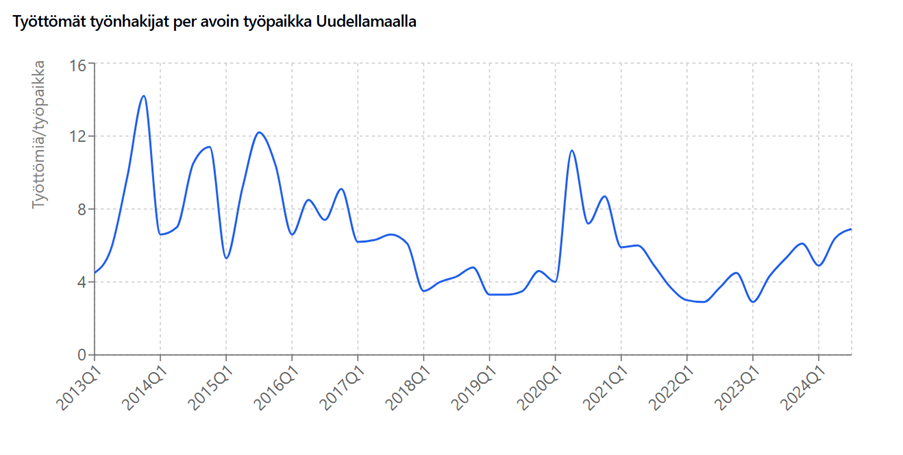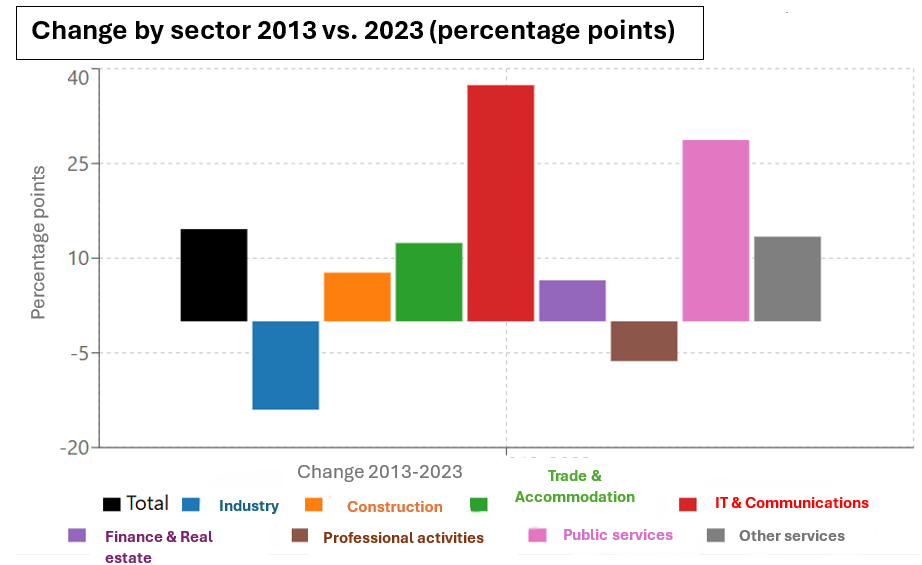Over the past ten years, there have consistently been more unemployed jobseekers than open job vacancies in the Helsinki-Uusimaa Region. At the same time, the proportion of hard-to-fill vacancies has increased significantly.
The proportion of hard-to-fill vacancies has increased significantly over the last decade. In 2013, their share was 37.7%, and by 2023 it had risen to 52.3% in the Helsinki Metropolitan Area, according to data provided by Statistics Finland to The Ami Foundation. The statistics for 2013–2024, in turn, show that the average ratio has been 6.9 unemployed individuals per job vacancy in the Helsinki-Uusimaa Region (Figure 1). This combination illustrates the issue of mismatch quite well. However, it is important to note that more and more vacancies are not publicly advertised.
According to Statistics Finland, a hard-to-fill vacancy is one that the employer has had difficulty in filling (subjective opinion). For example, despite active measures, there have been no applicants or the applicants have not been sufficiently qualified or suitable for the job in question. Despite the difficulties an employee may have been found to fill the vacancy, or the vacancy may have remained unfilled.

Y-axis: Unemployed/vacancy
Ratio calculated by dividing the data in the Job Vacancy Survey by the number of unemployed jobseekers.
Why are vacancies hard to fill?
Hard-to-fill vacancies can be caused by a variety of factors such as pay and related incentive traps, insufficient working hours offered, applicants’ skills, location of the job, employer requirements, and discrimination. For example, the high cost of housing in the Helsinki Metropolitan Area raises job seekers’ salary expectations, which can make recruitment more difficult. In addition, location plays an important role, especially in peripheral areas of the Helsinki-Uusimaa Region where public transport may be inadequate. Transport connections within the region are important to consider when talking about the Helsinki Metropolitan Area, as the Helsinki-Uusimaa Region is part of a regional employment area. Transport links within the Helsinki Metropolitan Area are not always optimal and commuting time can become a decisive issue for jobseekers. Location has a key impact on the attractiveness of jobs for jobseekers.
One important explanation for hard-to-fill vacancies is the mismatch between job seekers’ education levels and the employers’ requirements of available vacancies. For example, in the social and health care sector, many jobs require levels of educational qualification that not all applicants meet. This sector is also a major employer and one of the sectors most affected by labour shortages. Naturally, jobseekers who do not have the necessary qualifications for these vacancies are not viable candidates.
The challenges of matching skills with labour market needs are not limited to formal education requirements. Prolonged unemployment can reduce skills levels, as opportunities to update and develop skills while unemployed are limited. Further training and continuous on-the-job learning available to employed individuals are out of reach for the unemployed. As a result, long-term unemployment can lead to a gradual erosion or aging of skills, making it more difficult for individuals to re-enter the labour market.
The impact of discrimination and structural barriers on the number of hard-to-fill vacancies should be considered. In Finland, disability is the most common form of discrimination in the labour market, and health-related challenges significantly reduce employment opportunities. Age discrimination is also a recurrent issue in the public debate, with statistics showing that people over 55 have significantly more difficulty in finding employment compared to younger applicants. In addition to these challenges, jobseekers with a foreign background may face discrimination, for example, because having a foreign surname can make it difficult to find a job. One might ask whether a significant proportion of hard-to-fill vacancies would be easier to fill if discrimination in the labour market – in all its forms – could be reduced.
Challenges around skills identification are a key factor when it comes to the difficulty of filling jobs, affecting both employers and jobseekers. Recruiters often tend to use very narrow application criteria, for example, on the basis of a particular educational background or very specific system skills. Such strict restrictions significantly narrow the pool of potential candidates and may prevent the employment of skilled jobseekers. From the perspective of jobseekers, skills may be perceived as formal training only, or narrowly as skills acquired in previous jobs. However, many people have valuable skills acquired through hobbies, voluntary work, or involvement in associations, but these skills often go unrecognised and untapped.
What’s the solution?
The issue of mismatching is a complex phenomenon that cannot be explained by a single factor. Similarly, solving it is not the responsibility or in control of a single organisation. Given the scale and complexity of the subject, not all dimensions of the mismatch issue fall within the remit of any single organisation.
Anticipating skills needs is a key factor in tackling the challenge of hard-to-fill vacancies. Professional skills requirements are changing ever faster, making long-term forecasting challenging. For example, artificial intelligence is developing at such a pace that major technological developments are taking place within a single year. This creates challenges for training providers and employment areas responsible for providing workforce training, in particular, and these organisations may find it difficult to update their training provision with sufficient agility to respond to technological developments. This is why continuous efforts in skills forecasting are needed to identify and update training needs more quickly. This will ensure that the educational system can respond to the changing skills needs of companies and support labour supply more effectively.
Could the number of hard-to-fill vacancies be reduced if employers were to be more flexible about experience requirements, for example, making it easier for young people and those at the beginning of their careers to find work? Youth unemployment is on the rise, and more and more young people, including those with higher education qualifications, remain unemployed after graduation. As young people naturally have little work experience, it can be challenging for them to enter the labour market – but without job opportunities, experience does not build up either. Should employers be more flexible in recruiting young people, investing in on-the-job learning and developing induction programmes to help them start their careers? In addition, the criteria for job ads could be critically reviewed to ensure that work history requirements do not create an unnecessary barrier. At the same time, it would be useful to take into account that young people often have specific skills, for example, in the use of artificial intelligence, which is becoming increasingly important in many sectors.
Could more employers hire people with specific work ability whose working hours could be reduced or whose tasks could be adapted to their strengths and needs? People with specific work ability have significant but largely untapped potential which should be better exploited in the labour market. Employers should more actively assess how to adapt jobs and working environments to make it easier to recruit people with disabilities, for example. Even small changes can enable a more diverse and inclusive working life. The Ami Foundation is therefore particularly interested in funding projects and research that can improve the labour market position of people with specific work ability.
It is also important to consider whether the number of hard-to-fill vacancies could be reduced if age discrimination in the labour market was reduced. Finland has a much higher unemployment rate of people over 55 than other Nordic countries, which means that many experienced and skilled applicants are excluded from the labour market. This is a significant loss both for individuals and for the labour market as a whole. The notion that, for example, a 60-year-old should not be hired because they are approaching retirement is outdated and does not meet the needs of today’s working life. Experienced workers have valuable skills, extensive networks, and a deep understanding of their field. These are qualities that can bring significant added value to companies and organisations. The development of working life should therefore focus on reducing age discrimination and making better use of experienced people.
The functioning of the labour market could be significantly improved if different types of skills were more widely recognised and valued by employers and jobseekers alike. Skills are not limited to formal education and training, or to the tasks defined in an employment contract, but can also be acquired outside work, for example, through hobbies, voluntary work, and association life. To promote positive change in the labour market, a broader understanding of the identification and recognition of skills is needed. Rather than strict recruitment criteria based on specific skills or educational requirements, there should be an increasing emphasis on universal skills such as self-direction, social skills, learning, and problem-solving abilities. In a changing world of work, these skills are increasingly valuable and can be developed in a variety of ways – in education, at work, and in leisure time.
Do you have a project or study in the pipeline that will contribute to solving this mismatch? Find out more about The Ami Foundation’s project and research funding and get in touch!
Hard-to-fill vacancies in the Helsinki Metropolitan Area
In absolute terms, the number of hard-to-fill vacancies has almost tripled between 2013 and 2023, with an increase of 179.2%. This suggests that the labour market mismatch in the Helsinki Metropolitan Area has worsened significantly over this period. However, the number of job vacancies in 2024 has fallen, and unemployment has risen, so the 2024 statistics may differ significantly from the 2023 statistics. The overall situation of hard-to-fill vacancies in the Helsinki Metropolitan Area has evolved as follows from 2013 to 2023:
- In 2013, hard-to-fill vacancies accounted for 37.7% of all vacancies (2,811 / 7,455)
- In 2023, the corresponding figure was 52.3% (7,849 / 15,006)
- Total change over ten years: 14.6 percentage points
The total number of job vacancies has increased by 101.3% over the period (7,455 → 15,006), but the absolute number of hard-to-fill vacancies has increased by up to 179.2% (2,811 → 7,849). This shows that while the number of jobs has doubled, the number of hard-to-fill vacancies has almost tripled.
Sectoral trends for hard-to-fill vacancies
Industry:
- Proportion of hard-to-fill vacancies in 2013: 43.9%
- Proportion of hard-to-fill vacancies in 2023: 29.9%
- Change: -14.0 percentage points
Construction:
- Proportion of hard-to-fill vacancies in 2013: 60.0%
- Proportion of hard-to-fill vacancies in 2023: 67.7%
- Change: +7.7 percentage points
Trade, transport and storage, accommodation and food service activities:
- Proportion of hard-to-fill vacancies in 2013: 36.9%
- Proportion of hard-to-fill vacancies in 2023: 49.3%
- Change: +12.4 percentage points
Information and communications:
- Proportion of hard-to-fill vacancies in 2013: 24.4%
- Proportion of hard-to-fill vacancies in 2023: 61.8%
- Change: +37.4 percentage points
Financial and insurance activities, real estate business activities:
- Proportion of hard-to-fill vacancies in 2013: 43.6%
- Proportion of hard-to-fill vacancies in 2023: 50.1%
- Change: +6.5 percentage points
Professional, scientific and technical activities, administrative and support service activities:
- Proportion of hard-to-fill vacancies in 2013: 46.5%
- Proportion of hard-to-fill vacancies in 2023: 40.2%
- Change: -6.3 percentage points
Public administration, education, health and social services:
- Proportion of hard-to-fill vacancies in 2013: 35.7%
- Proportion of hard-to-fill vacancies in 2023: 64.4%
- Change: +28.7 percentage points
Other services:
- Proportion of hard-to-fill vacancies in 2013: 23.6%
- Proportion of hard-to-fill vacancies in 2023: 37.0%
- Change: +13.4 percentage points

